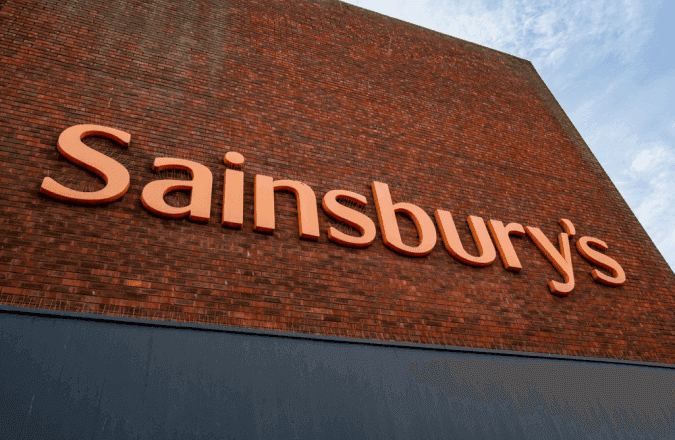How to trade Sainsbury's stock: a complete guide

Learn all about Sainsbury's, with information on the company’s history and share price journey, its share trading hours, and how to trade Sainsbury's share CFDs with Capital.com.
What is Sainsbury's?
Headquartered in London, Sainsbury's is a British supermarket chain dating back to 1849, when it was founded as a small dairy shop by John James Sainsbury and his wife Mary Ann Sainsbury. After gradual expansion over the years, it now operates more than 1,400 stores across the UK and Ireland, offering a wide range of products from groceries to home goods, clothes, electronics, and more.
Sainsbury's listed on the London Stock Exchange in 1973 under the ticker symbol SBRY, by which point it was firmly established as a major domestic supermarket player. However, the period after its IPO saw significant expansion and market share growth. The share price journey in the years since has seen many peaks and troughs, influenced by factors such as competitive advantages, the consumer retail climate, and strategic decisions.
In the 2023 fiscal year, the company’s revenue amounted to around £30.9bn.
What is Sainsbury's’ share price history?
Sainsbury's share price history, beginning in 1973, has seen its ups and downs as discussed. Last century, a standout year was 1997 as the chain expanded its retail footprint and built on its reputation for quality products and good customer service. However, operational issues, strategic missteps and intense competition made the stock less appealing in the following year.
This century, 2006 saw a turnaround strategy implemented which addressed the customer shopping experience, revitalised product offerings, and improved its supply chain efficiencies. During this time, celebrity chef Jamie Oliver also helped bring visibility to the brand, in an endorsement reportedly worth £1.2 million to Oliver.
However, the financial crisis and resulting recession of 2008 hit consumer confidence badly, with disposable incomes falling and unemployment rising, meaning the stock saw a dramatic fall. In the years since, intense competition in a tough sector has caused challenges that have contributed to some industry-wide volatility.
*Sainsbury's stock price data from Macrotrends. Correct as of 27 March 2024.
(Past performance is not a reliable indicator of future results)
What factors might affect the Sainsbury's live share price?
Sainsbury's’ share price can be impacted by a range of key sector-specific fundamental events. Here are a few of the main factors that traders should watch out for.
-
General financial performance/earnings reports: the supermarket’s financial position, including sales performance, profitability, and margins, is a key factor that can influence its share price at any given time, with strong earnings reports liable to boost investor confidence, particularly if the performance is unexpectedly high. Conversely, there may be an outsized share price slump where results come in lower than expected.
-
Competitive landscape: competition in the grocery retail market is fierce. Particular in modern times, a regular theme for middle-market retailers such as Sainsbury’s is navigating pricing pressures from discount retailers and online competitors, and progress here can shape the company’s market position, profitability and share price patterns. Ongoing knowledge of competitive strategy, pricing initiatives, and market positioning are therefore critical for those trading this stock.
-
Leadership: the UK retail sector is known for celebrated leaders such as Justin King of Sainsbury’s, David Potts of Morrisons, and Tesco’s Dave Lewis, all of whom have been praised as instrumental to positive outcomes. Strong leadership in this sector means an eye for customer experience and how to differentiate the offering from competitors. But both good and bad executive decisions can influence investors and traders, meaning potential fluctuations in share price either way. This means that any new appointments or leadership changes are well worth looking out for.
-
Risk management and crisis response: management's ability to identify and mitigate risks, as well as effectively navigate crises or challenges, is also key for protecting shareholder value. In supermarkets, such a risk might be supply chain disruption affecting certain product lines, or a reputational issue based on a cybersecurity breach or misfiring advertising campaign. Investors assess management's risk management practices, crisis response capabilities, and resilience in adverse situations.
What are the Sainsbury's stock trading hours?
The Sainsbury's stock trading hours are Monday to Friday from 8:00am to 4:30pm (UK time), corresponding to 7:00am to 3:30pm (UTC).
If you choose to trade CFDs, you can follow the Sainsbury's stock performance live in GBP with the comprehensive Sainsbury's share price chart.
Monitoring the company’s activity can help you to keep an eye out for any key fundamental or technical events that may affect short-term movements in the share value.
How to trade Sainsbury's shares with CFDs
If you want to take a position on Sainsbury's shares, you have two options. First, you can buy physical shares in the company through the exchange on which it’s listed. In this case, investing in Sainsbury's stock means you will own a share, or shares, in the company. This can be considered a long-term investment, as you’re hoping for the price to rise over time.
Alternatively, you can trade a derivative product such as a contract for difference (CFD) on the underlying Sainsbury's stock market price, and speculate on its price movements without actually owning the asset. A CFD is a financial contract, typically between a broker and a trader, where one party agrees to pay the other the difference in the value of a security, between the opening and closing of the trade.
Unlike physical share ownership, you can either hold a long position (speculating that the price will rise) or a short position (speculating that the price will fall). This is considered a short-term investment or trade, as CFDs tend to be used within shorter timeframes.
Another key difference between buying physical Sainsbury's shares and trading through a derivative is the leverage that can be employed with the latter. CFDs are traded on margin, which means that a trader can access larger positions with a relatively small outlay. This amplifies the potential profits, but also the potential losses, making leveraged trading risky. You can learn how to trade shares in our comprehensive guide to shares trading.
To trade Sainsbury's stock CFDs with us, just sign up for a Capital.com account, and once you’re verified, you can use our advanced web platform or download our intuitive yet easy-to-use app. It’ll take just a few minutes to get started and access the world’s most-traded markets.
Need more support? Try our step-by-step stocks course to guide you through the basics to the advanced concepts.
Why trade Sainsbury's CFDs with Capital.com
Trading CFDs with Capital.com means you’ll enjoy an intuitive, easy-to-use platform, 24/7 support, fair and transparent pricing, along with award-winning education to help build your experience in the markets.* You can seamlessly integrate our smart platform with elite third-party software TradingView and MT4, and refine your strategies with our risk-free demo.
*Awarded best-in-class for education at ForexBrokers.com’s 2024 Annual Awards
FAQs
Who owns Sainsbury's?
The ownership structure of Sainsbury's mainly comprises institutions such as the investment vehicle of the Qatari royal family and Vesa Equity Investment. Lord Sainsbury of Turville, the great-grandson of founder John James Sainsbury and erstwhile chairman has also held a notable stake in recent times.
How much are Sainsbury's shares?
As with any asset, the Sainsbury's share price is dynamic and liable to change at any time. If you’re trading this stock, it’s important to check out the Sainsbury's chart frequently to keep on top of price movements, as well as retain a strong understanding of the fundamental and technical influences that can cause the price to shift.
What market is Sainsbury's listed on?
Sainsbury's has been listed on the London Stock Exchange since its IPO in 1973.
What is Sainsbury’s’ market share?
Sainsbury’s’ market share is dynamic and is beholden to competitive factors related to pricing, reputation, and quality. UK grocery market share has been dominated by Tesco in recent years, but discounters like Lidl and Aldi have made ground amid prolonged cost-of-living concerns. Sainsbury’s has historically been jostling for second place with Asda, but traders should keep a keen eye on the performance of rivals.
How to trade Sainsbury's shares
If you want to invest in Sainsbury's, you can buy and own the physical share, for example through a stockbroker, at a price you think you can profit on in time. Alternatively, trading a derivative, for example through a CFD, can give you leveraged exposure to the underlying price without ownership. However, leverage amplifies both profits and losses, making it risky.
Is Sainsbury's a good stock to buy right now?
Whether Sainsbury's is a good stock to buy is dependent on market conditions and the individual judgement of traders. On a technical level, you might consider technical indicators such as the RSI or MACD to identify potential support and resistance. From a fundamental standpoint, a knowledge of the standing of competitors, earnings release timings, and the regulatory landscape are all key factors that could influence your buy or sell decisions.
Visit our other complete guides

How to trade Coca-Cola
